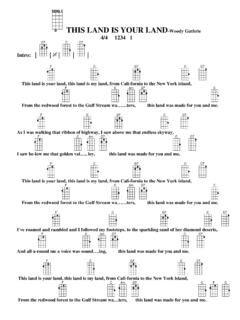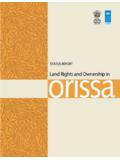Transcription of Capital Budget Summary - Maryland General …
1 LA11 Department of Agriculture Capital For further information contact: Andrew D. Gray Phone: (410) 946-5530 Analysis of the FY 2016 Maryland Executive Budget , 2015 1 Capital Budget Summary Grant and Loan Capital Improvement Program ($ in Millions) Program FY 2014 Approp. FY 2015 Approp. FY 2016 Request FY 2017 Estimate FY 2018 Estimate FY 2019 Estimate FY 2020 Estimate Maryland Agricultural land Preservation Program1 $ $ $ $ $ $ $ Tobacco Transition Program2 Maryland Agricultural Cost-Share Program Total $ $ $ $ $ $ $ 1 The fiscal 2016 request does not include $ million in transfer tax special funds reduced contingent upon the Budget Reconciliation and Financing Act of 2015 redirecting the revenues to the General fund since under the Governor s proposed Budget , these funds are not available for program use.
2 2 The fiscal 2015 appropriation reflects the $ million reduction approved as part of the July 2, 2014 Board of Public Works actions. Fund Source FY 2014 Approp. FY 2015 Approp. FY 2016 Request FY 2017 Estimate FY 2018 Estimate FY 2019 Estimate FY 2020 Estimate PAYGO SF $ $ $ $ $ $ $ GO Bonds1 Total $ $ $ $ $ $ $ GO: General obligation PAYGO: pay-as-you-go SF: special funds 1 Pre-authorizations of General obligation bonds for the Maryland Agricultural land Preservation Program included in the Maryland Consolidated Capital Bond Loan (MCCBL) of 2014, representing transfer tax funding that has been or will be redirected to the General fund between fiscal 2014 and 2018, have been struck in the MCCBL of 2015 as follows: fiscal 2016 ($ million), 2017 ($ million), 2018 ($ million), 2019 ($ million), and 2020 ($ million).
3 LA11 Department of Agriculture Capital Analysis of the FY 2016 Maryland Executive Budget , 2015 2 Summary of Issues Maryland Agricultural land Preservation Program Repeat Audit Finding: The Maryland Agricultural land Preservation Program (MALPP) is audited annually by the Office of Legislative Audits. The most recent audit came out on June 19, 2014, and covers the period beginning July 1, 2012, and ending June 30, 2013. MALPP had one finding a repeat finding that the Maryland Agricultural land Preservation Foundation (MALPF) did not ensure that all easement violations were resolved in a timely manner. The total number of unresolved easement violations has increased from 348 through June 30, 2013 (the most recent audit data), to 561 as of January 12, 2015. The Department of Legislative Services (DLS) recommends that the Maryland Department of Agriculture (MDA) comment on why the number of unresolved violations has increased substantially from 348 in the most recent audit to 561 as of January 12, 2015.
4 Food Hub Plans Still Vague: The General Assembly added Budget bill language to the fiscal 2015 Capital and operating Budget bills restricting funding provided for three food hub projects the Baltimore Food Hub, the Eastern Shore Food Hub, and the Regional Food Hub in Southern Maryland until reports were submitted on how efforts were being coordinated. The report was submitted and funding released, but it is still unclear how the Southern Maryland Agricultural Development Commission (SMADC) will pursue its food hub vision. DLS recommends that SMADC comment on how the proposed food hub will work with local farmers to improve both availability of locally grown produce and the economic conditions of local farmers. SMADC should also describe a business plan, including a Capital schedule, for its proposed food hub vision using its fiscal 2015 and 2016 funding.
5 Summary of Updates Request for Easement Termination Denied: The Howard County Commissioners denied the requests to terminate the Mullinix Brothers Partnership s easements in January 2014, and the MALPF Board of Trustees denied the petitions for all easement termination applications on December 2, 2014. Subsequently, the Mullinix Brothers Partnership has filed a petition for judicial review in the Circuit Court of Howard County. MALPF is waiting to receive the petition from the circuit court. MDA notes that there are no other requests for termination. LA11 Department of Agriculture Capital Analysis of the FY 2016 Maryland Executive Budget , 2015 3 Summary of Recommended PAYGO Actions Funds 1. Maryland Agricultural land Preservation Program Concur with the contingent reduction of $9,830,434 in special finds in the Maryland Agricultural land Preservation Program.
6 2. Concur with Governor s allowance for the Tobacco Transition Program of $868,000 in special funds for agricultural land preservation. Total Reductions Summary of Recommended Bond Actions Funds 1. Maryland Agricultural land Preservation Program Reduce authorization to reflect equitable replacement funding with Program Open Space. $11,406,910 GO 2. Maryland Agricultural Cost-Share Program Approve the $2,000,000 General obligation bond authorization for the Maryland Agricultural Cost-Share Program. Total Reductions $11,406,910 LA11 Department of Agriculture Capital Analysis of the FY 2016 Maryland Executive Budget , 2015 4 Program Description The MDA Capital program is comprised of MALPP, the Tobacco Transition Program, and the Maryland Agricultural Cost-Share (MACS) Program. The programs fit under MDA s goals to preserve adequate amounts of productive agricultural land and woodland in Maryland ; promote profitable production, use, and sale of Maryland agricultural products; and provide and promote land stewardship.
7 Descriptions of the three programs follow. Maryland Agricultural land Preservation Program The General Assembly created MALPP to preserve productive agricultural land and woodland, which provides for the continued production of food and fiber; limit the extent of urban development; and protect agricultural land and woodland as open space. MALPF, with the assistance and cooperation of landowners and local governments, purchases development rights easements as a means of protecting agricultural land and woodland production activities. Chapter 12 of 2014 (MALPF Value of Easement) modified the maximum price MALPF may pay for an easement. Formerly the maximum price was the landowner s asking price or the easement value, whichever is lower. Chapter 12 of 2014 prohibited MALPF from purchasing an easement for more than 75% or less than 25% of the fair market value of the land .
8 MALPF is authorized to purchase an easement for less than 25% of the fair market value of the land only if the owner s asking price is less than 25% of the fair market value of the land . The easement value is determined by subtracting the agricultural value from the appraised fair market value of the property. Once the development rights have been sold, the property is perpetually protected from further development, with certain rights available only to the owners who originally sold the easement. Tobacco Transition Program In 1999, the General Assembly created the Cigarette Restitution Fund (CRF). Under the legislation, one purpose of the CRF is to fund the implementation of the Southern Maryland Regional Strategy Action Plan for Agriculture adopted by the Tri-County Council (TCC) for Southern Maryland with an emphasis on alternative crop uses for agricultural land used for growing tobacco.
9 Funds are appropriated to MDA, which then issues grants to TCC. TCC is a nonprofit, quasi-governmental body that works with SMADC to develop programs to stabilize the region s agricultural economy as Maryland growers transition away from tobacco production. TCC s Strategy Action Plan has three main components: the tobacco buyout (first priority), agricultural land preservation (second priority), and infrastructure/agricultural development (third priority). Final tobacco buyout funding was budgeted for fiscal 2014. Maryland Agricultural Cost-Share Program The MACS Program provides financial assistance to Maryland farmers for installing 1 or more of 30 nationally recognized best management practices (BMP) that reduce soil and nutrient runoff from farmland. The program requires a minimum cost-share match from grantees.
10 Animal waste treatment and containment projects are funded up to $200,000 per project, with a maximum of $300,000 per farm for all animal waste management practices and up to $450,000 per farm when combined with other BMPs, and up to $200,000 per project under a pooling agreement to solve a pollution LA11 Department of Agriculture Capital Analysis of the FY 2016 Maryland Executive Budget , 2015 5 problem on two or more farms. All other BMPs are funded up to $50,000 per project, with a maximum of $150,000 per farm per person, and up to $100,000 per project under a pooling agreement to solve a pollution problem on two or more farms. Performance Measures and Outputs Maryland Agricultural land Preservation Program Agricultural land is desirable for conversion to other uses, such as residential development. MALPP is one tool for keeping farmland in agriculture, as is the agricultural use assessment for taxation purposes.

















